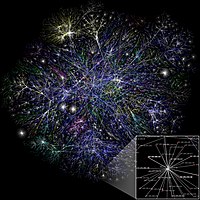
Photo from wikipedia
Strategic network formation is a branch of network science that takes an economic perspective to the creation of social networks, considering that actors in a network form links in order… Click to show full abstract
Strategic network formation is a branch of network science that takes an economic perspective to the creation of social networks, considering that actors in a network form links in order to maximise some utility that they attain through their connections to other actors in the network. In particular, Jackson’s Connections model, writes an actor’s utility as a sum over all other actors that can be reached along a path in the network of a benefit value that diminishes with the path length. In this paper, we are interested in the “social capital” that an actor retains due to their position in the network. Social capital can be understood as an ability to bond with actors, as well as an ability to form a bridge that connects otherwise disconnected actors. This bridging benefit has previously been modelled in another “structural hole” network formation game, proposed by Kleinberg. In this paper, we develop an approach that generalises the utility of Kleinberg’s game and combines it with that of the Connections model, to create a utility that models both the bonding and bridging capabilities of an actor with social capital. From this utility and its associated formation game, we derive a new centrality measure, which we dub “structural hole centrality”, to identify actors with high social capital. We analyse this measure by applying it to networks of different types, and assessing its correlation to other centrality metrics, using a benchmark dataset of 299 networks, drawn from different domains. Finally, using one social network from the dataset, we illustrate how an actor’s “structural hole centrality profile” can be used to identify their bridging and bonding value to the network.
Journal Title: Computational Social Networks
Year Published: 2020
Link to full text (if available)
Share on Social Media: Sign Up to like & get
recommendations!